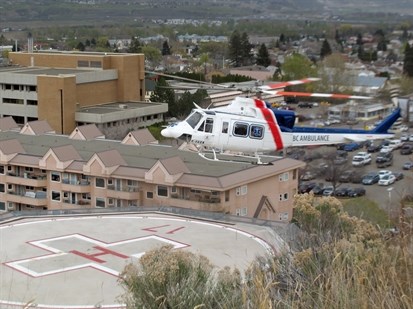
Royal Inland Hospital is one major incident away from being in crisis according to a recently created advocacy group.
(JENNIFER STAHN / iNFOnews.ca)
April 15, 2013 - 5:11 PM
According to a doctor at Royal Inland Hospital, the last time the facility was not above capacity was almost a year ago. Now staff and administration are doing everything they can to avert a crisis.
Dr. Sean Gorman says the RIH usually sees surges in winter and summer with a capacity drop off in between, but this year was the exception with almost all days at a minimum of 115 per cent of capacity. He says most days the hospital is running at over 120 per cent capacity with several days over 130 per cent. There are 220 available beds so 130 per cent means approximately 70 more people than available beds are admitted to the hospital.
Monday afternoon the province announced it approved the business plan for a new clinical services building and 350 new parking stalls. The clinical services building is one step in a multi-phase master development plan that Gorman says will be in progress for nine to 10 years before any sort of relief from current overcrowding is felt. He says something needs to be done in the interim to address these issues.
As a surgeon at the hospital - and a member of a recently formed medical staff advocacy group - Gorman has seen the fluctuations over the past seven years and though staff anticipated this would be the toughest year in memory, being over capacity continuously has put a strain on staff and patients as the risk of antibiotic resistant organisms and infections continues to increase.
“People have no right to not be confident though,” Gorman says, “the talent here is spectacular, (staff and administration) have accomplished so much with so little.”
Staff have utilized spaces never before used, such as staff lounges and the cast and ambulatory care clinics, and everyone has been willing to give 110 per cent, unfortunately when you are at 130 per cent there is still some shortfall, Gorman says, and staff start to get burned out.
RIH is the third busiest trauma hospital in the province and services many small towns – including communities as far north as Clearwater and 100 Mile House – which is something other Southern Interior hospitals do not do. Combined with the meeting of two major highways RIH is different than many other hospitals.
The hospital sees an average of a five per cent annual increase in capacity which means until more space is created or found for the hospital, the over capacity issues will only get worse.
“We don't need a new hospital, we need more space at our hospital,” Gorman says, noting that would still only address long-term problems and that something still needs to be done between now and then.
Gorman says hospital administrator Marg Brown “is a genius” for keeping the hospital running as efficiently as it has been, which includes the cancelling of 22 elective surgeries on Friday – a move Gorman says has helped keep levels at a more reasonable capacity over the weekend and into this week as opposed to the 132 per cent level the hospital reached on Thursday, April 11.
At 132 per cent, Gorman described the hospital as “gridlocked” with admitted patients in all ambulatory care clinics and halls and cancer surgery patients staying in the operating room recovery area. B.C. Ambulance also started to reinforce a policy to no longer stay with patients once delivered to hospital, one they rarely enforce.
A lack of coverage in some communities forced the ambulance service to pull that part of their service, a service that cost upwards of $200,000 to RIH in 2012.
Brown says the high volumes at the hospital have been going on for almost four months and capacity levels have been higher than ever before. In an effort to alleviate some of the pressure, several long-term initiatives have been taken, she said.
Work on an alternate level of care strategy has been created to assist pairing up the “right person with the right place, at the right time” to help provide the best possible care.
“We're working closely with community partners,” Brown says, “it will bear fruit down the road, not immediately.”
This has included “home first” care for elderly patients, people with chronic breathing problems and mental illnesses.
A meeting Thursday afternoon between administration and local leaders is one of several recent meetings with community leaders to help everyone understand the full impact of the overcrowding.
We need to educate community leaders and senior administration and ensure the public is well aware of the risks. The concept of risk is really important,” Gorman says,” and we are doing everything to avert a crisis. We are managing a critical situation right now. We're only one major multi-car or bus crash away from being at a crisis level.”
To contact a reporter for this story, email jstahn@infotelnews.ca or call (250) 819-3723.
News from © iNFOnews, 2013